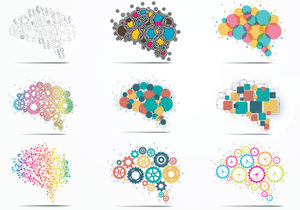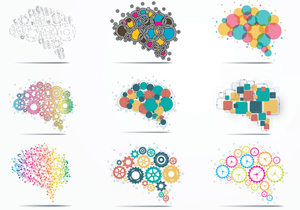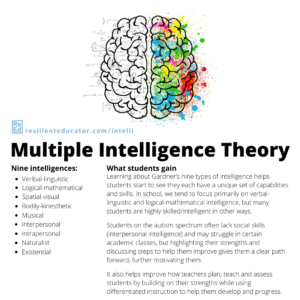
Students often equate intelligence with grades and/or test scores. But teaching students about Howard Gardner’s multiple intelligences theory can show them that they are all intelligent in different ways. This perspective can boost their confidence and increase their motivation to learn.
What is Gardner’s multiple intelligences theory?
Gardner is a professor of education at Harvard University whose groundbreaking research in psychology and human cognition helped him develop a theory that we each have distinct intellectual abilities that we demonstrate with unique aptitudes. Initially, his multiple intelligences theory identified six types of intelligence. But over the years it evolved, and now there are nine types — with the possibility for others.
The nine multiple intelligences are:
 Verbal-linguistic: demonstrates strong verbal communication, advanced vocabulary, etc.
Verbal-linguistic: demonstrates strong verbal communication, advanced vocabulary, etc.- Logical-mathematical: understands logical and numerical patterns as well as abstract concepts
- Spatial-visual: visualizes accurately and uses abstract information to picture the information in one’s head
- Bodily-kinesthetic: skillfully uses and controls the body and objects
- Musical: produces rhythm and pitch, and appreciates musical values
- Interpersonal: responds appropriately to others by understanding social cues, motivations and moods
- Intrapersonal: aware of one’s own feelings, values and thinking processes
- Naturalist: identifies and categorizes animals, plants and other aspects of nature
- Existential: contemplates deep questions about human existence, including the purpose of life, how we came to be, etc.
Students often combine intelligences when they do activities or assignments, such as working in a group to create a map based on information given (spatial-visual and interpersonal intelligences), or writing a reflective essay about a personal problem they learned from (intrapersonal and verbal-linguistic).
Though activities can help multiple types of intelligences strengthen each other, trouble may crop up if students feel stupid because they’re struggling with one aspect of an assignment or activity. The real problem in these cases is a misunderstanding of how multiple intelligences create opportunities for growth.
What students gain from the multiple intelligences theory
Learning about Gardner’s nine types of intelligence helps students start to see they each have a unique set of capabilities and skills. In school, we tend to focus primarily on verbal-linguistic and logical-mathematical intelligence, but many students are highly skilled/intelligent in other ways.
You are probably thinking of some of them right now. English learners often struggle with confidence in the classroom and sometimes aren’t as motivated when they feel “stupid” simply because they are learning another language. But showing them that they are highly intelligent in other ways gives them an opportunity to strengthen their self-image and recognize that they still have the potential to do well.
Students on the autism spectrum often lack social skills (interpersonal intelligence) and may struggle in certain academic classes, but highlighting their strengths and discussing steps to help them improve gives them a clear path forward, further motivating them. Students also can build their self-awareness by painting a picture of their preferences, personality traits and strengths.
Helping students understand why multiple intelligences matter
When you show students how tests often assess only a few types of intelligence, you can spark meaningful conversations about this limited point of view. Many tests are worded and formatted for certain types of intelligence, which can prevent students from demonstrating the full scope of their knowledge and capabilities.
Each of us has a range of skills, strengths and weaknesses. Teaching our students about the multiple intelligences theory shows them they each have something important to offer in every class or situation, and that our differences can strengthen us as a whole.
You can also have students fill out a questionnaire to assess their multiple intelligences. This personalizes the theory and gives them ownership over their learning so they can be their own advocates.
It also helps you improve how you plan, teach and assess them by building on their strengths while using differentiated instruction to help them develop and progress.
Kara Wyman has a BA in literature and an MEd from University of California-Santa Barbara. She has worked with adolescents for a decade as a middle school and high school English teacher, the founder and director of a drama program, and a curriculum designer for high school and college courses. She works with 13- to 19-year-old students as a project manager of a nonprofit organization.
Categorized as: Tips for Teachers and Classroom Resources
Tagged as: Mid-Career Teacher, New Teacher, Professional Development

